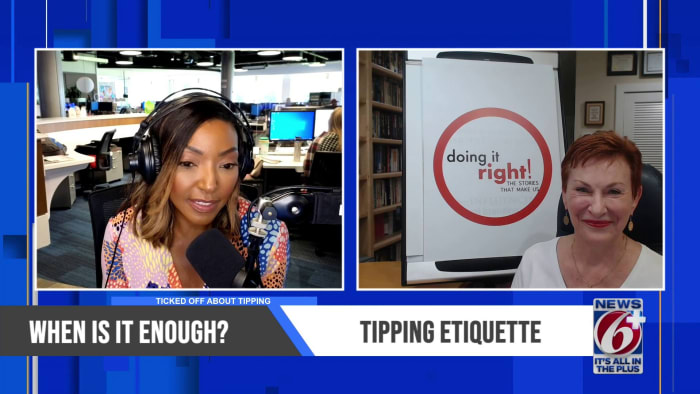Perhaps you’ve noticed. We have reached a tipping point in the country over tipping.
To tip or not to tip has led to Shakespearean soliloquies by customers explaining why they refuse to tip for certain things.
During the height of the COVID-19 pandemic, customers were grateful for those who seemingly risked their safety so we could get groceries, order dinner or anything that made our lives feel normal. A nice tip was the least we could do to show gratitude.
But now that we are out about and back to normal, the custom of tipping for just about everything has somehow remained; and customers are upset.
A new study from Pew Research shows most American adults say tipping is expected in more places than it was five years ago, and there’s no real consensus about how tipping should work.



This doesn’t actually happen though. Consumers still pay the additional cost. The cost is just hidden.
I know many states have their own laws around minimum wage, but we’re looking at the whole so we’ll use the federal wage guidelines.
Ok, so the federal minimum wage is $7.25/hr, or $2.13/hr for tipped employees as long as they make at least $5.12/hr in tips to meet the minimum wage requirement.
So we have Pat, who is a server in a restaurant. The restaurant pays minimum wage ($2.13 + tips). Pat makes the national median in tips ($100/day). Assuming an 8 hour day that is $100/8 = $12.50/hour + $2.13 minimum = $14.63/hour.
The restaurant is right in the middle of the road on cost at $15/per person. Pat has a 5 table section, for an average we’ll assume Pat has one person at each table each hour the entire shift or $15 x 5 tables x 8 hours. This is $600.00 earned for the restaurant.
Most restaurant business operators prefer the food costs to be between 28 and 35 percent of the menu price. So of that $600.00, $390.00 is income after food costs. But there’s still payroll to account for. In the tipping model, $17.04 of that is payroll. That leaves $362.96. Let’s just say $62.96 is other expenses, that leaves $300.00 in income for the business. $300 dollars earned of the labor of a server they paid $17.04 to.
If they paid Pat what they make with tips $14.63*8 = $117.04 then we’re looking at $390 after food costs minus $117.04 + $62.96 leaves us with $210.00 in income. In this scenario the server is paid a fair wage for their labor (or at least the same in the tipping model) the business didn’t have to raise their prices because they’re still profiting, and the customer could still tip if they appreciated the service.
The cost isn’t hidden, it’s manufactured by businesses that don’t want to lose out on profit by paying their employees a fair wage instead of having customers subsidize them.
In case you were wondering the math if Pat got no tips works out to $390.00 revenue - $66.00 payroll - $62.96 other expenses = $261.04 income for the business.
Revenue from food pays for back-of-house employees too, which you are not including in your math.
This is a lot of very basic math, and I commend you for trying, but this is not the necessary math to manage any functioning business, much less a restaurant.
Also I can’t imagine a server who would be happy with 12/hr take-home, and in your specific example, 12/hr that is also taxed significantly more than tipped wages.
Have you ever worked in a restaurant?
Yep, they’re paid from all the tables, not just a single server. I do account for additional expenses in my calculations and none of this includes alcohol sales which bolsters many restaurants earnings more than food.
It is basic math to highlight how it’s exploitative to the worker, which directly ties into tipping connection to racism and slavery in the US, the topic of this discussion we’re having. I’m also not trying to run a restaurant or business but, basic addition and subtraction is how every business runs, with credits and debits in the ledger. Condescend to someone else.
Ok, I’m not really sure how your lack of imagination is relevant to the fact that tipped work is exploitative to the workers. By the way, based on the averages from the federal DoL, there are tipped workers who make $12/hr take home or less. If scope is reduced to a certain state or municipality then those numbers would change drastically based on location, but so would the wage requirements because the federal is the bare minimum. Anywhere that is different would have more protection for the worker in higher guaranteed minimum wages because they were granted by the state or municipality.
I have not, do people who work in restaurants use some fancy alternate reality where the facts are different? I’m going to be done discussing this with you because I don’t really care to go down a rabbit hole of twisting arguments until you feel like you won.
The fact that tipped wage work got its beginnings in the US due in part to racism and slavery is relevant and it is still exploitative towards workers. Facts don’t need you to believe in them to exist or be true.
They understand how costs work in restaurants, and that servers do not generally work 8 hour days, among other things.
For instance, you’d need to double your labor costs for FOH because any server that makes $100 in 8 hours is fucking starving to death because that is terrible. That’s a double, if not slightly more than a double, and giving up an entire day for $100 makes no financial sense.
You thinking servers claim 100% of tips is another reason you really shouldnt try to argue about something you have no experience with.
Ok 👍
Imagine if you just woke up today and chose to get smarter instead of shittier.